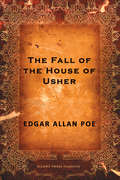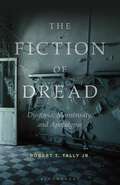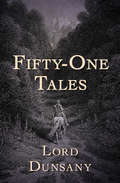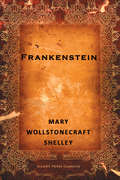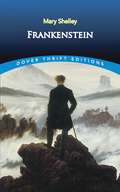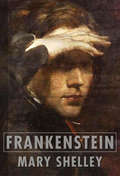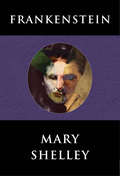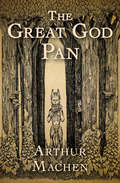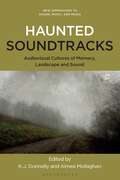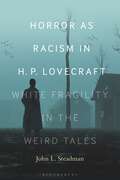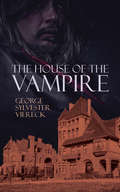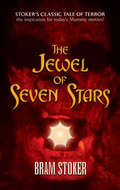- Table View
- List View
The Evil Dead (Devil's Advocates)
by Lloyd HaynesSam Raimi’s The Evil Dead (1981) is one of the most inventive and energetic horror movies of the last 40 years. Released during a period in which the stalk-and-slash cycle had blunted the horror genre of much of its creative edge, Raimi’s debut feature transcends its small budget and limited resources to deliver a phantasmagoric roller-coaster ride, a wildly absurd and surreal assault on the senses. Still original enough to stand on its own and be considered as a genre classic, this book will explain its long-lasting appeal and impact. After detailing the unique circumstances of its origin, Lloyd Haynes goes on to analyse key aspects of the film’s abiding success. The Evil Dead is one of a number of horror films which locate their terrors in a single setting and limited time frame. Haynes argues that it creates a ‘bad dream’ effect in which the nightmare is never-ending and increasingly horrific, and how the cabin-in-the-woods location is also a fine example of the ‘bad place’ motif which stretches back to the Gothic novels of the 18th century. The book goes on to consider what character traits Ash Williams, The Evil Dead’s ‘macho’ male hero, shares with Carol Clover’s ‘Final Girl’ model and how effective he is as a ‘Final Guy’. Finally, it explores the critical approaches to the film, in particular its notorious reputation in Britain as a ‘video nasty’.
The Fall of the House of Usher
by Edgar Allan PoeThe fate of the Usher ancestral home rests on the heads of Roderick and Madeline Usher—siblings afflicted with psychological illnesses that will prove to be their undoing. A master of the mysterious and the macabre, Edgar Allan Poe's short stories explore the human psyche. "The Fall of the House of Usher" is considered to be one of the author's most famous works, and is a masterpiece of American Gothic literature.
El fantasma de Canterville
by Oscar WildeCuando el millonario Hiram B. Otis y su familia se instalaron en el antiguo castillo de los Canterville, Simon, el fantasma, se restregó las manos: tendría por fin la oportunidad de aterrorizar a un grupo de odiados norteamericanos. No sabía lo que le esperaba. En esta divertida historia Oscar Wilde (1854-1900) despliega su inmenso talento para el humor, la ironía y el sarcasmo
The Fiction of Dread: Dystopia, Monstrosity, and Apocalypse
by Dr Robert T. Tally Jr.A history and examination of dystopia and angst in popular culture that speaks to our current climate of dread.At the dawn of the 20th century, a wide-ranging utopianism dominated popular and intellectual cultures throughout Europe and America. However, in the aftermathof the World Wars, with such canonical examples as Brave New World and Nineteen-Eighty-Four, dystopia emerged as a dominant genre, in literature and in social thought. The continuing presence and eventual dominance of dystopian themes in popular culture-e.g., dismal authoritarian future states, sinister global conspiracies, post-apocalyptic landscapes, a proliferation of horrific monsters, and end-of-the-world fantasies-have confirmed the degree to which the 21st is also a dystopian century.Drawing on literature as varied as H.G. Wells's The Time Machine, Neil Gaiman's American Gods, and Suzanne Collins's The Hunger Games, and on TV and film such as The Walking Dead, Black Mirror, and The Last of Us, Robert T. Tally Jr. explores the landscape of angst created by the monstrous accumulation of dystopian material. The Fiction of Dread provides an innovative reading of contemporary culture and offers an alternative vision for critical theory and practice at a moment when, as has been famously observed, it is easier to imagine the end of the world than the end of capitalism.
Fifty-One Tales
by Lord DunsanyA classic collection of short stories from one of the twentieth century’s most influential fantasy authors. Irish author Lord Dunsany majorly influenced generations of writers, including J. R. R. Tolkien, H. P. Lovecraft, and many more, and his Fifty-One Tales, a collection of short stories first published in 1915, has delighted readers for more than a century. These vignettes—some no more than a few paragraphs long—offer brief glimpses into worlds of sparkling wit and imagination. By turns whimsical, satirical, and melancholic, this collection (also published under the title The Food of Death) touches on timeless themes and remains a wellspring of inspiration and pleasure. This ebook has been professionally proofread to ensure accuracy and readability on all devices. “[Dunsany’s] rich language, his cosmic point of view, his remote dream-world, and his exquisite sense of the fantastic all appeal to me more than anything else in modern literature.” —H. P. Lovecraft
Frankenstein
by Mary ShelleyThe eccentric Dr. Victor Frankenstein creates life from assembled body parts, only to realise his creature is an abomination. He casts the monster out, deeply regretting his work. When the monster, despondent at his creator's disgust, attempts to befriend humans, he is rejected – a rejection that leads to violence and great loss for Frankenstein. A thematic indictment of blind ambition and man's fear of the unknown, Frankenstein endures as a classic piece of English literature and the inspiration for countless film and television adaptations.
Frankenstein: Or the Modern Prometheus (Dover Thrift Editions)
by Mary ShelleyFew creatures of horror have seized readers' imaginations and held them for so long as the anguished monster of Mary Shelley's Frankenstein. The story of Victor Frankenstein's terrible creation and the havoc it caused has enthralled generations of readers and inspired countless writers of horror and suspense. Considering the novel's enduring success, it is remarkable that it began merely as a whim of Lord Byron's."We will each write a story," Byron announced to his next-door neighbors, Mary Wollstonecraft Godwin and her lover Percy Bysshe Shelley. The friends were summering on the shores of Lake Geneva in Switzerland in 1816, Shelley still unknown as a poet and Byron writing the third canto of Childe Harold. When continued rains kept them confined indoors, all agreed to Byron's proposal.The illustrious poets failed to complete their ghost stories, but Mary Shelley rose supremely to the challenge. With Frankenstein, she succeeded admirably in the task she set for herself: to create a story that, in her own words, "would speak to the mysterious fears of our nature and awaken thrilling horror — one to make the reader dread to look round, to curdle the blood, and quicken the beatings of the heart."
Frankenstein, or The Modern Prometheus
by Mary ShelleyFrankenstein, or The Modern Prometheus is a novel written by English author Mary Shelley (1797–1851) that tells the story of Victor Frankenstein, a young scientist who creates a grotesque but sapient creature in an unorthodox scientific experiment. His monster has become one of the most recognized characters in all of literature.
Frankenstein, or The Modern Prometheus
by Mary ShelleyFrankenstein, or The Modern Prometheus is a novel written by English author Mary Shelley (1797–1851) that tells the story of Victor Frankenstein, a young scientist who creates a grotesque but sapient creature in an unorthodox scientific experiment. His monster has become one of the most recognized characters in all of literature.
Frankenstein, or the Modern Prometheus
by Mary Wollstonecraft ShelleyClassic horror story. Victor Frankenstein is obsessed with creating life. His botched creature sets out to destroy Frankenstein, and all he holds dear.
A Girl Walks Home Alone at Night (Devil's Advocates)
by Farshid KazemiThere is something weird and eerie going on in the oneiric Iranian ghost-town Bad City. A mysterious female vampire, clad in a long-black veil, imbued with occult and erotic power, has newly arrived in town and is summarily dispensing with its unsavory characters. Through a chance encounter in a night of luminal darkness, an eternally dark romance begins – baptized in love’s blood. Shot in dazzling anamorphic black and white cinematography and accompanied with an intoxicating and mesmeric soundtrack, Ana Lily Amirpour’s debut feature film A Girl Walks Home Alone At Night (2014), was an instant popular and critical success. Dubbed ‘the first Iranian vampire western’ the genre-bending film is a pastiche of genres such as vampire cinema, gothic and horror films, spaghetti westerns, graphic novels, and Iranian cinema; yet the film stands as a new vampire fairy-tale with a unique style all its own. The first full-length study dedicated to the film since its release, this book in the Devil’s Advocate series provides a unique approach to the film situated within three theoretical coordinates: the vampire genre, psychoanalytic (film) theory and German Idealism.
The Great God Pan
by Arthur MachenA gothic masterpiece set in Victorian England: “One of the best horror stories ever written. Perhaps the best in the English language” (Stephen King). When Mr. Clarke agrees to visit his friend Dr. Raymond, he is dubious about the proceedings he is to witness. In pursuit of what Raymond calls “transcendental science,” the doctor intends to make a small incision in a woman’s brain, allowing her to see past the world of the senses to a reality beyond imagining—a realm where, Raymond says, one can see the great god Pan. Though the experiment is an apparent failure, it will not be Clarke’s last brush with the sinister beyond. Years later, Clarke hears of a woman named Helen Vaughan, who is said to be at the root of many mysterious and tragic events. From London to the Americas and back, a string of suicides and disappearances lay in the wake of this evil seductress, whom Clarke believes is not entirely of this world. Upon publication in 1890, Arthur Machen’s The Great God Pan was deemed controversial for its depictions of paganism and sexual depravity. It has since been recognized as a masterwork of gothic horror. This ebook has been professionally proofread to ensure accuracy and readability on all devices.
Haunted Soundtracks: Audiovisual Cultures of Memory, Landscape, and Sound (New Approaches to Sound, Music, and Media)
The turn of the millennium has heralded an outgrowth of culture that demonstrates an awareness of the ephemeral nature of history and the complexity underpinning the relationship between location and the past. This has been especially apparent in the shifting relationship between landscape, memory and sound in film, television and other media. The result is growing interest in soundtracks, as part of audiovisual culture, as well as an interest in the spectral aspects of culture more generally. This collection of essays focuses on audiovisual forms that foreground landscape, sound and memory. The scope of inquiry emphasises the ghostly qualities of a certain body of soundtracks, extending beyond merely the idea of 'scary films' or 'haunted houses.' Rather, the notion of sonic haunting is tied to ideas of trauma, anxiety or nostalgia associated with spatial and temporal dislocation in contemporary society. Touchstones for the approach are the concepts of psychogeography and hauntology, pervasive and established critical strategies that are interrogated and refined in relation to the reification of the spectral within the soundtracks under consideration here.
Horror as Racism in H. P. Lovecraft: White Fragility in the Weird Tales
by Dr. or Prof. John L. SteadmanProviding a new perspective on Lovecraft's life and work, Horror as Racism in H.P. Lovecraft focuses on the overlap between the writer's personal beliefs and the racist images and narratives in his speculative fiction. Building on recent debates about Lovecraft and drawing on the concept of "white fragility," John Steadman argues that the writer's fiction reflects his feelings of resentment and anger towards non-white persons and was used to advocate for his racist, xenophobic political beliefs – that western civilization was in decline and slavery was justifiable among "superior" civilizations. In making these claims, Lovecraft's tales pit humans against extra-terrestrial aliens, developing a terrifying, futuristic vision of the Earth as a plantation planet. The familiar image of Lovecraft as a reclusive, creative genius and mentor to young writer-friends is dismantled through close readings of his fiction and nonfiction – including correspondence, essays, and poetry – and examination of his early biography. This image is replaced by that of a cruel, callous, and, at times, psychotic man, a violently vitriolic racist and white supremacist who hated most of the non-white races. While some will dismiss the author outright and others will read his fiction but ignore the racism, Horror as Racism in H.P. Lovecraft takes a middle ground: acknowledging Lovecraft's personal history and heinous intentions, it helps readers navigate the author's disturbing biography while also getting a better sense of the stories, which remain significant within American science fiction.
The House of the Vampire
by George Sylvester Viereck"He felt the presence of the hand of Reginald Clark - unmistakably - groping in his brain as if searching for something that had still escaped him. He tried to move, to cry out, but his limbs were paralyzed. When, by a superhuman effort, he at last succeeded in shaking off the numbness that held him enchained, he awoke just in time to see a figure, that of a man, disappearing in the wall that separated Reginald's apartments from his room..."This vampire doesn't want the blood from your veins; he's after the ideas in your head. The hypnotic Reginald Clarke chooses his victims for their artistic abilities, charms them, and discards them after robbing them of their gifts. Originally published in 1907, this gothic novella was among the first stories of its type and remains a gripping tale of psychic vampirism.
I Walked With a Zombie (Devil's Advocates)
by Clive DawsonI Walked with a Zombie (1943), Val Lewton's second feature for RKO Radio Pictures, was described by critic Robin Wood as 'perhaps the most delicate poetic fantasy in the American Cinema.' Following immediately in the wake of the groundbreaking Cat People (1942), Zombie pioneered an even more radical narrative approach yet proved to be the critical and commercial equal of its predecessor, cementing the reputation of both Lewton and his director, Jacques Tourneur. Despite the lurid, studio-imposed title, I Walked with a Zombie is a subtle and ambiguous visual poem that advanced a daring condemnation of slavery and colonialism at a time when such themes were being actively suppressed by government censors. Clive Dawson charts the complex development and production of the project, essential to understanding the concerns of the filmmakers in the context of wartime Hollywood, then analyses the film in detail, referencing a broad range of academic studies of the audio-visual text and distilling new insight into its layers of meaning. Finally, he explores the film's reception, and the influence it exerted on the horror genre and beyond. Extensive primary research has uncovered a wealth of previously unpublished new material that solves many unanswered questions and dispels various myths about this utterly unique film.
IT Chapters One and Two (Devil's Advocates)
by Alissa BurgerDrawing on critical analysis of film, the horror genre, the Gothic, and Stephen King scholarship, this book considers Andy Muschietti’s IT Chapter One (2017) and IT Chapter Two (2019) on multiple levels: as film (both as individual films and through their interconnected narrative), as adaptation, and as a barometer of the horror film’s popularity among fans. Key points of consideration include the significance of the fictional town of Derry as a traditionally Gothic “bad place,” the role of 1980s nostalgia in these two films, the complex navigation of memory and trauma, gender representation, queer representation, and the return of the repressed. The terrifying figure of Pennywise the clown is central to this analysis, including consideration of performance, costuming, and significance within the larger landscape of the “scary clown” popular culture trope, and through comparison to Tim Curry’s iconic performance in Tommy Lee Wallace’s 1990 miniseries. This Devil's Advocate contextualizes Muschietti’s films within the larger landscape of King’s literary and popular culture influence, as well as the debate surrounding “elevated” horror and the “horror boom” of the late 2010s.
The Jewel of Seven Stars
by Bram StokerSomeone has seized the fabled Jewel of Seven Stars from the mummy's grip, and the ancient Egyptian queen Tera has risen from her tomb to take it back—at any cost! This thrilling tale of adventure and ritual magic recounts a supernatural struggle in which archeologists, grave robbers, and anyone else who attempts to possess the Jewel meet a mysterious, violent fate.Bram Stoker, the author of Dracula, wrote this enthralling novel of possession, reincarnation, and an ancient curse at the peak of the Victorian fascination with Egyptology. His spellbinding blend of Eastern lore and classic horror fiction formed the template for the plots of dozens of mummy movies. This edition features the original ending as it appeared in the 1903 publication, a gripping conclusion that was censored in subsequent printings and long unavailable.

